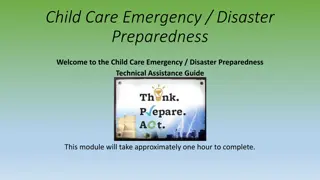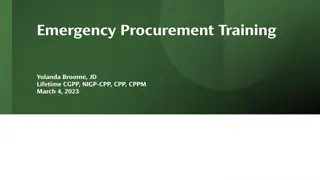Emergency Assessment Guide for Medical Professionals
Comprehensive emergency assessment guide covering primary and secondary assessments, triage classification, and differentiation of emergent, urgent, and non-urgent medical conditions. Includes initial assessment steps, Glasgow Coma Scale evaluation, and key interventions for life-threatening situations. Essential resource for healthcare practitioners in managing critical situations efficiently and effectively.
Uploaded on Sep 21, 2024 | 2 Views
Download Presentation

Please find below an Image/Link to download the presentation.
The content on the website is provided AS IS for your information and personal use only. It may not be sold, licensed, or shared on other websites without obtaining consent from the author.If you encounter any issues during the download, it is possible that the publisher has removed the file from their server.
You are allowed to download the files provided on this website for personal or commercial use, subject to the condition that they are used lawfully. All files are the property of their respective owners.
The content on the website is provided AS IS for your information and personal use only. It may not be sold, licensed, or shared on other websites without obtaining consent from the author.
E N D
Presentation Transcript
CSI 102 Skills Lab 5 EMERGENCY ASSESSMENT Daryl P. Lofaso, Ph.D., M.Ed., RRT
Initial Assessment Guide Primary Assessment Observational Assessment Appearance conscious, unconscious, alert Work of Breathing (WOB) accessory muscle use Circulation color, bleeding Intervention to any life-threatening condition
Initial Assessment Guide Secondary Assessment (Serial) Vital Signs: initial and after treatment Glasgow Coma Scale (GCS) Range 3-15 Three Behaviors: Eye opening response (1-4) Best verbal response (1-5) Best motor response (1-6)
Primary Assessment A = Airway / C-spine immobilization B = Breathing C = Circulation D = Disability or Neurologic Status
Secondary Assessment E = Exposure and environmental control to prevent heat loss F = Full set of vital signs, wt. G = Give comfort measures H = Head-to-toe assessment and History (Hx) I = Inspect posterior surfaces
Triage Assessment Emergent Urgent Non-urgent
Emergent Airway and Breathing Difficulties Cardiac Arrest C-spine compromise Seizure states Life or limb-threatening condition Severe medical problems (Overdose, poisoning, DM complications) Obvious multiple injuries Excessive high temperature (> 105oF or 40.5oC) Cardiac CP Neurological Deficit Stroke (CVA)
Urgent Chest Pain (Non-Cardiac) Burns Decrease level of conscious ( LOC) Persistent nausea, vomiting, or diarrhea Severe pain Temperature (102-105oF or 39o-40.5oC) Mental Health Crisis Seizure Allergic Reaction Large broken bones Delay of up to 2 hrs. will not compromise life or limb
Non-Urgent Chronic backache Moderate headache Minor Fx or other injuries Cough or Congestion Tooth or ear ache Need Stitches Urinary tract infection Stable illness or injury, wait > than 2 hrs. without an increased risk of morbidity or mortality
What is an illness script? A network of acquired knowledge and experience about a disease, set of conditions, or symptoms basically it s what you know about a disease. Pathophysiology process/insult: What is it? What causes it? Predisposing factors: Who gets it? Clinical manifestation: What does it look like? What are the prototypical history and exam features?
Adult Vital Signs Pulse: 60-100/minute Blood Pressure: <120/<80 mmHg Respiration: 12-20/minute Temperature: 98.6oF or 37oC Pulse oximeter: > 94% saturation
Patient s Condition Stable VS within normal limits. Pt conscious & comfortable. Guarded VS within normal limits. Pt has some discomfort. Unstable VS outside of normal limits. Major complications. Prognosis guarded.
Universal Precautions All Patients are potentially infectious. Good Hand Hygiene is the key to reducing nosocomial infections Wash before and after patient contact Wear a mask, eye protection, gloves and gown when needed
3 Types of Precautions Airborne Droplet Contact
Pathogens Requiring Airborne Precautions Tuberculosis Measles (Rubeola) Varicella (Chickenpox) COVID-19
Airborne Precautions Management Place patient in an isolation room with negative pressure Keep door closed Wear N-95 mask
Pathogens Requiring Contact Precautions Multi-drug resistance bacteria (e.g., VRE Vancomycin Resistant Enterococci, MRSA - Methicillin Resistant Staphylococcus Aureus) RSV - Respiratory Syncytial Virus Clostridium difficile Scabies























